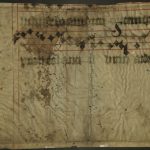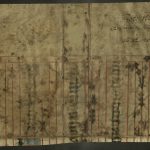Fragment of the Graduale and Sequentionale Varadinense.
On the fragment’s second folio parts of the Uterus virgineus sequence’s 3-8th strophes were preserved. According to the Analecta Hymnica and the data of online databases (CANTUS; https://hymnologica.cz/) the sequence written in honour of the Virgin Mary is primarily traceable in German and Bohemian sources. Considering the repertory and the ordering of chants of the Várad codices it is remarkable, that in the 14-15th-century gradual of the Prague cathedral the sequence Uterus virgineus directly precedes the prose Ave virginalis forma: the truly rare chant, whose only Hungarian source is the Sequentionale Varadinense. Comp. Graduale („Marianum”) Praha, Knihovna Národního muzea, ms. XII A 1, f. 73v, 76r. The facsimile of the source is accessible on www.manuscriptorium.com . Based on this parallel the Sequ. Uterus virgineus may have also belonged to the Bohemian “guest-chants” of the Várad mass codices.
Zsuzsa Czagány





